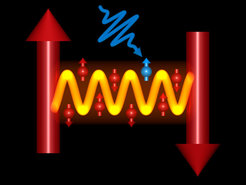Manipulating magnetic forces with light

The interaction between microscopically small ‘spins’ (magnetic moments) determines the strength of magnets and is dependent on the interactions between the electrons in magnetic materials. These electrons can be rapidly manipulated with an electric field such as one from laser light. But what happens subsequently to the magnetic forces is widely unknown, because existing theoretical concepts cannot account for changes of magnetism on so short timescales. Mentink and Eckstein have combined two state-of-the-art methods to calculate these ultrarapid processes. Their results show that the magnetic forces adapt almost instantaneously to the exited state of electrons, and can thus be quickly and effectively manipulated with light.
Weaker magnetism for stronger hard disks
Weakening the magnetism makes it easier to switch magnetic bits from north (0) to south (1), a mechanism used in hard disks, for example. With the best current technology it takes about one nanosecond to switch magnetic bits. Mentink and Eckstein have demonstrated that magnetic forces can be weakened more than 10,000 times faster than the fastest switching time possible with current technology. This knowledge might in future be applied to an entirely new generation of magnetic devices that respond to electric fields, just as modern laser technology is used in medical equipment, for example.
Creating magnetism
The researchers demonstrated the effect to be large in a relatively simple model for an insulating material. This result forms a starting point for further research on other materials and different types of lasers and to measure whether the magnetism can also be strengthened, for example. Mentink: ‘Our dream is to make a non-magnetic material magnetic so as to add greater functionality to its use. It is still too early to make specific predictions but imagine, for example, that you could make silicon or graphene magnetic. That would have an enormous impact on future technological developments.’
Rubicon
Johan Mentink received a NWO Rubicon grant for his work in the research group of Martin Eckstein at the University of Hamburg CFEL/MPSD. More information on the Rubicon programme of the Netherlands organization for Scientific Research (NWO) can be found at www.nwo.nl.

